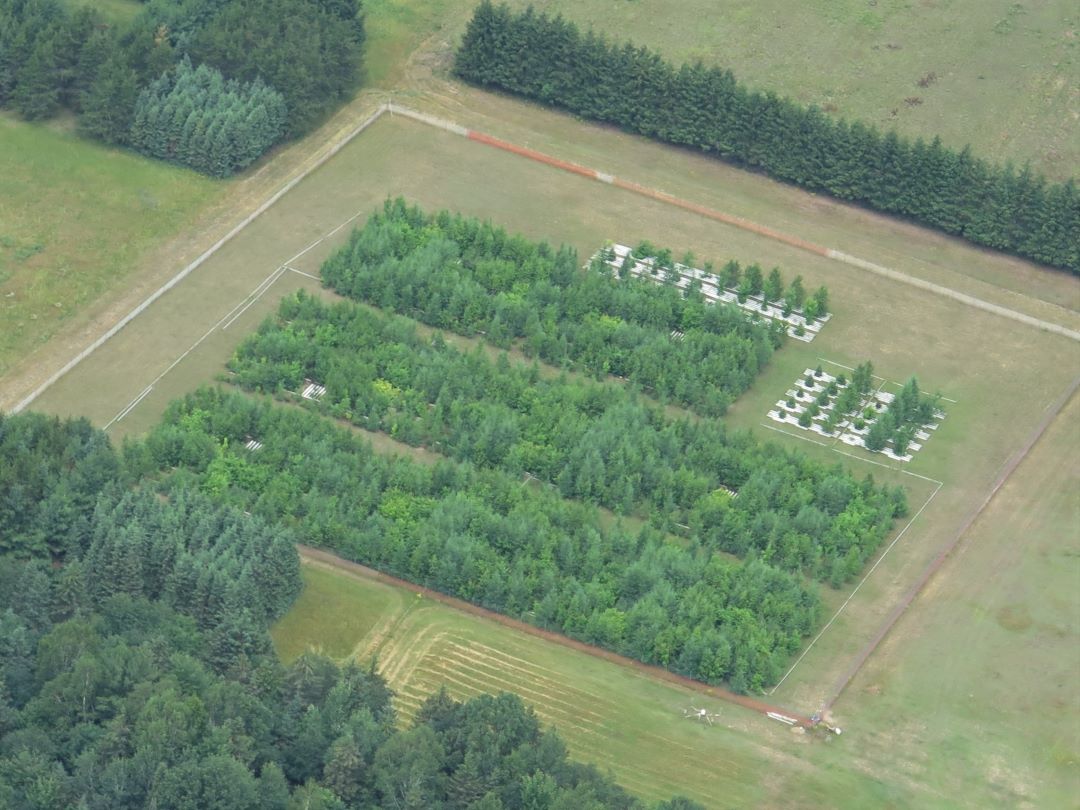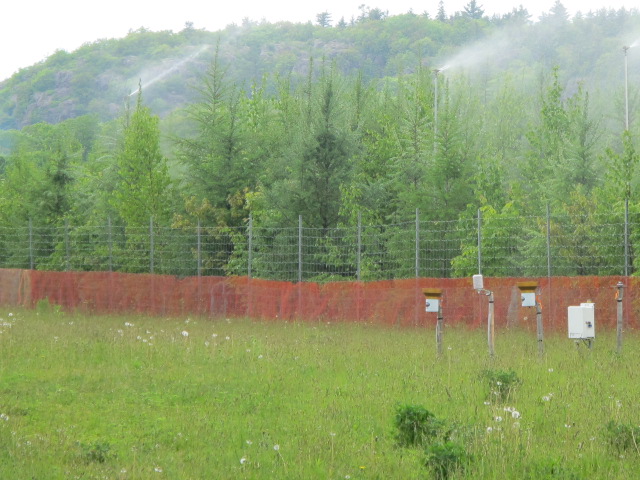IDENT (Canada, USA, Germany, Italy, Ethiopia)
The International Diversity Experiment Network with Trees (IDENT) is a network of Biodiversity - Ecosystem Functioning (BEF) experiments in North America, Europe, and Africa. The main characteristics of IDENT within TreeDivNet are the focus on the early years of tree development, the role of functional diversity, and BEF relationships over stress gradients. The experiment consists of eight sites: six in temperate ecoregions, one in a Mediterranean region, and one in a tropical region. In total, 2241 plots have been planted with native as well as exotic tree species. At four of the sites, the impacts of water availability and nutrient addition are studied as well. Application trials linked to this experiment are: Bessonne, Lac-aux-Brochets, and Lyster (Canada).
Design
Two gradients are established, i.e., a species richness (SR) gradient and a functional diversity (FD) gradient, in order to allow separating the two different diversity effects. The FD gradient consists of species combinations of equal SR but different FD. To enable isolating the effect of FD, as opposed to the impact of the presence/absence of specific species or traits, the FD levels are repeated using different species compositions and are pooled in groups of similar FD value.
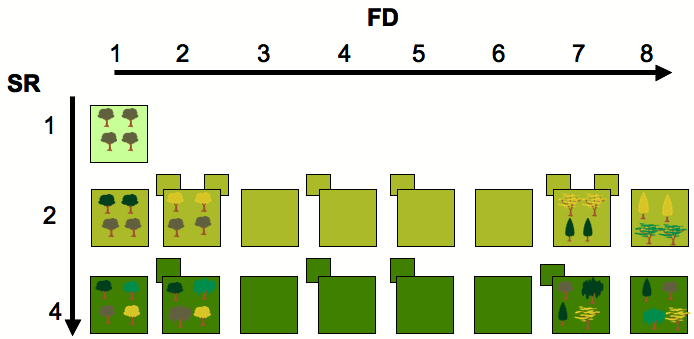
On different sites, IDENT also includes additional experimental treatments that are related to the link between climate change, stress gradients and forest resilience, and the interactions between native and exotic species. Water availability is manipulated through irrigation or partial removal of rainfall at two of the sites. Nets are used for the shading treatment at the Ethiopia site. Six congeneric pairs of North American and European tree species are planted at four of the sites. The fertilization treatment (1 site) consists of N addition, P addition, and N+P addition. The extra treatments are implemented by doubling the replication of a given FD gradient over a constant SR level to accommodate both a control and a manipulated treatment.
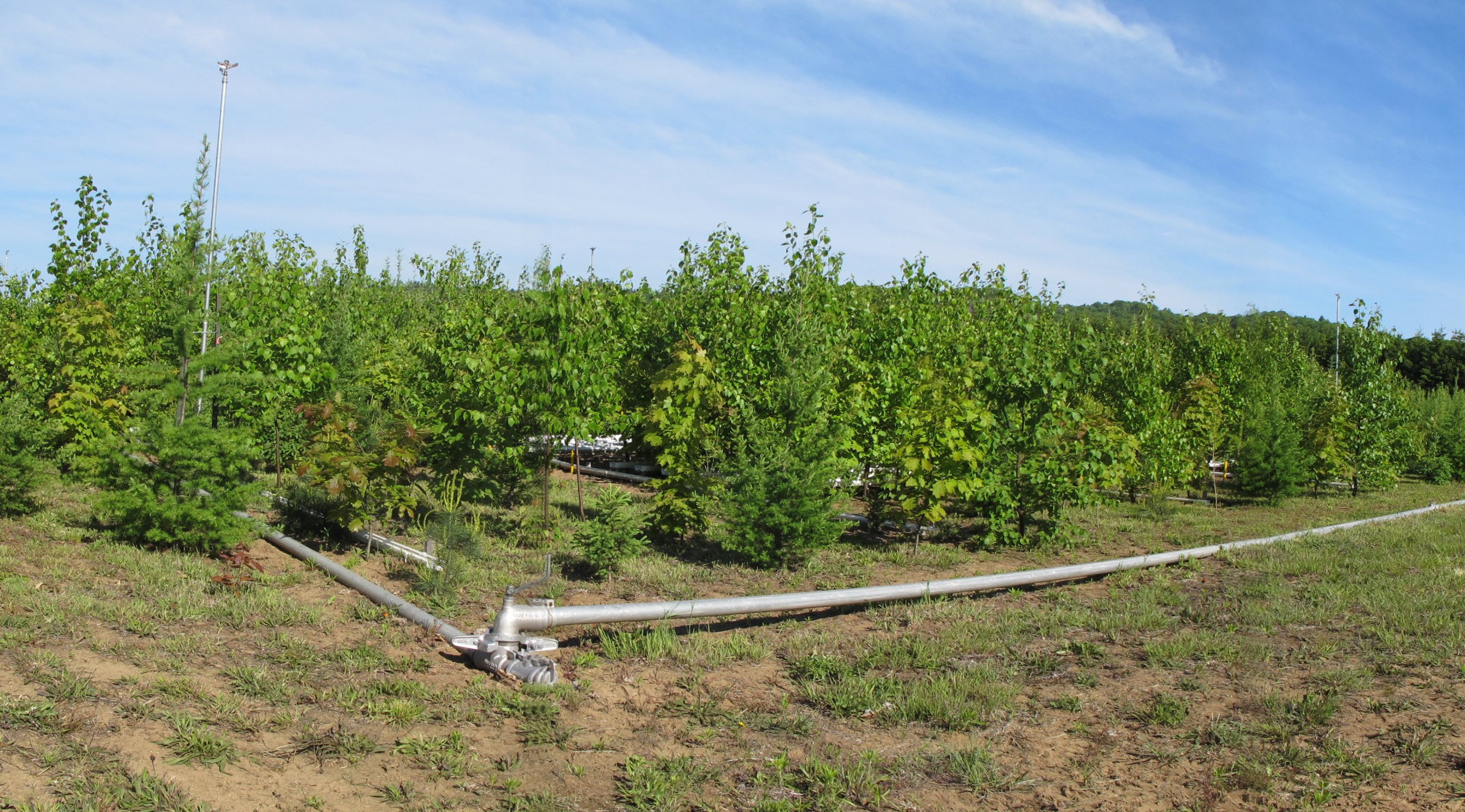
Irrigation and rain removal equipment at the Sault-Ste-Marie site (2016, 2019)
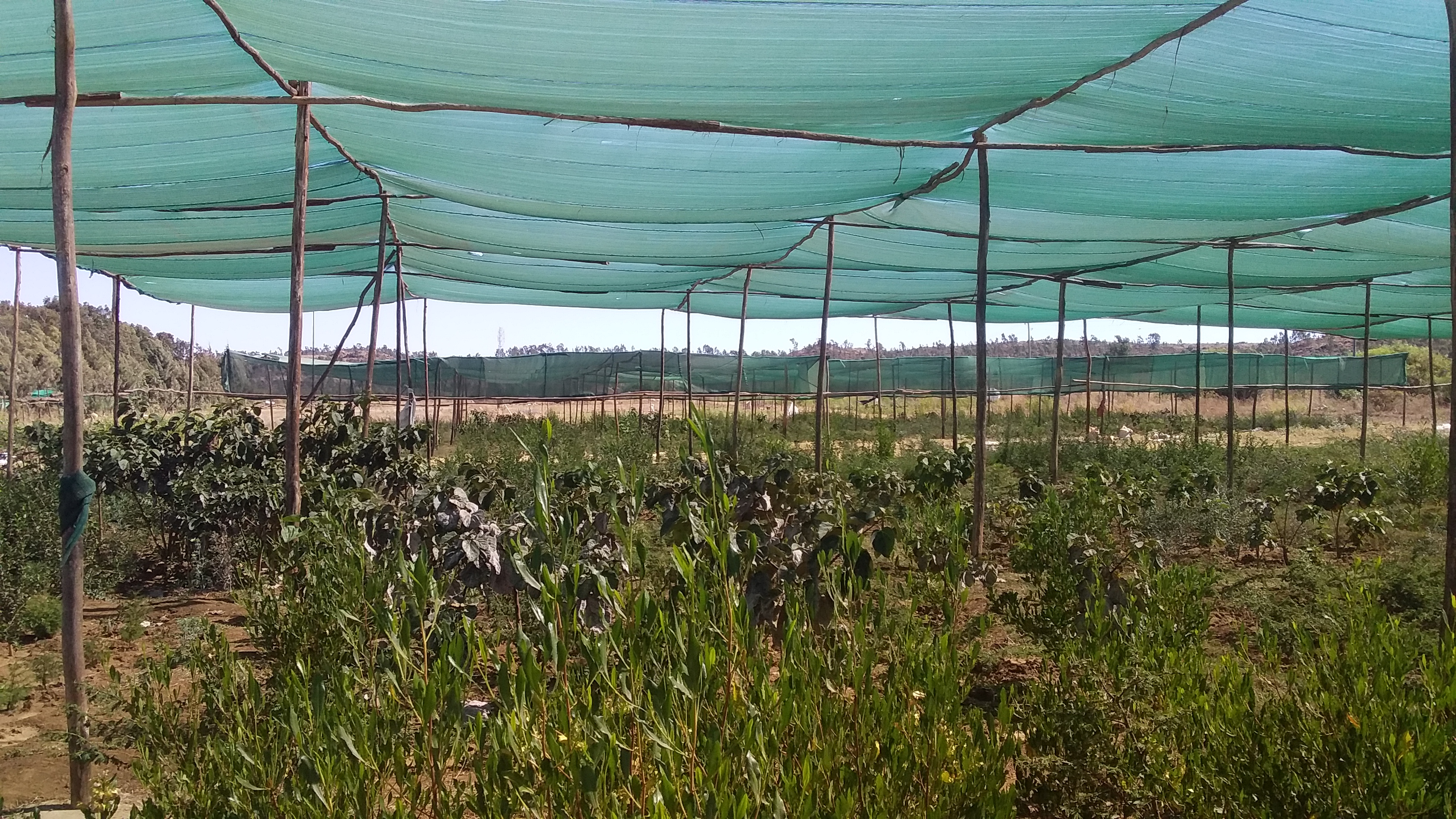
As the focus in IDENT is on the early successional stage of stand development, the trees are planted in high density, i.e., 40 to 60 cm apart, to accelerate species interactions. In most cases, square plots contain 7 x 7 or 8 x 8 trees. At each site, the plots are positioned randomly in a block.
Site characteristics
| IDENT (Montreal) | IDENT (Auclair) | IDENT (Cloquet) | IDENT (Sault-Ste-Marie) | IDENT (Freiburg) | IDENT (FAB) | IDENT (Outaouais) | IDENT (Macomer) | IDENT (Ethiopia) | |
|---|---|---|---|---|---|---|---|---|---|
| Country | Canada | Canada | USA | Canada | Germany | USA | Canada | Italy | Ethiopia |
| Biome | temperate | temperate | temperate | temperate | temperate | temperate | temperate | Mediterranean | tropical |
| Latitude | 45.42 | 47.7 | 46.68 | 46.5164 | 48.02007201 | 45.4 | 45.774667000000001 | 40.24 | 13.48 |
| Longitude | -73.94 | -68.66 | -92.52 | -84.3376 | 7.8254278140000002 | -93.19 | -75.007833000000005 | 8.72 | 39.46 |
| Soil type | sandy | loam | sandy loam | sandy loam | sandy | sandy | Sandy loam | silt loam | Vertisol (FAO system) |
| Former land use | high-input agriculture | low-input abandoned agriculture | forest | low-input abandoned agriculture | grassland pasture | low-input abandoned fields | Old experimental plot with shrubs, grasses and trees | tree nursery, unused for 5 years | cropland |
| Altitude | 39 m | 333 m | 383 m | 210 m | 278 m | 279 m | 175 m | 615 m | 2200 m |
| Design | stem-wise randomisation | stem-wise randomisation | stem-wise randomisation | systematic randomisation | stem-wise randomisation | stem-wise randomisation | stem-wise randomisation | stem-wise randomization | |
| Plot shape | square | square | square | square | square | square | square | ||
| Plot size (m^2) | 16 m² | 10.24 m² | 10.24 m131 | 10.24 m132 | 10.24 m133 | 20.25 m² | 12.25 m² 16 m² |
10.24 m² | 32.49 m² |
| Plant distance (m) | 0.5 | 0.4 | 0.4 | 0.4 | 0.45 | 0.4-0.5 | 0.4 | ||
| Number of trees planted | 13 824 | 9 408 | 9 408 | 9 016 | 19 992 | 8 960 | 15788 (2020) 1536 (2021) 1280 (2022) |
19 712 | 17 280 |
| Planting date | 2009 | 2010 | 2010 | 2013 | 2013 | 2013 | 2020-2021-2022 | 2014 | 2019 |
| Diversity variables | species richness functional diversity |
species richness functional diversity |
species richness functional diversity |
species richness functional diversity phylogenetic diversity |
species richness functional diversity phylogenetic diversity |
species richness functional diversity phylogenetic diversity |
species richness functional diversity phylogenetic diversity |
species richness functional diversity phylogenetic diversity |
species richness functional diversity |
| Size species pool | 19 | 12 | 12 | 6 | 12 | 12 | 6 | 12 | 9 |
| Species pool | Abies balsamea Acer platanoides Acer rubrum Acer saccharum Betula alleghaniensis Betula papyrifera Larix decidua Larix laricina Picea abies Picea glauca Picea omorika Picea rubens Pinus resinosa Pinus strobus Pinus sylvestris Quercus robur Quercus rubra Tilia cordata Thuja occidentalis |
Acer platanoides Acer saccharum Betula papyrifera Betula pendula Larix decidua Larix laricina Picea abies Picea glauca Pinus strobus Pinus sylvestris Quercus robur Quercus rubra |
Acer platanoides Acer saccharum Betula papyrifera Betula pendula Larix decidua Larix laricina Picea abies Picea glauca Pinus strobus Pinus sylvestris Quercus robur Quercus rubra |
Acer saccharum Betula papyrifera Larix laricina Picea glauca Pinus strobus Quercus rubra |
Acer platanoides Acer saccharum Betula papyrifera Betula pendula Larix decidua Larix laricina Picea abies Picea pungens var. glauca Pinus strobus Pinus sylvestris Quercus robur Quercus rubra |
Acer negundo Acer rubrum Betula papyrifera Juniperus virginiana Pinus banksiana Pinus resinosa Pinus strobus Quercus alba Quercus ellipsoidalis Quercus macrocarpa Quercus rubra Tilia americana |
Acer saccharum Quercus rubra Betula alleghaniensis Picea glauca Pinus resinosa Larix laricina |
Acer monspessulanum Arbutus unedo Fraxinus ornus Olea europea Phillyrea latifolia Pinus halepensis Pinus pinaster Pinus pinea Pistacia lentiscus Quercus ilex Quercus pubescens Quercus suber |
Acacia abyssinica Afrocarpus falcatus Cordia africana Dodonaea angustifolia Dovyalis abyssinica Faidherbia albida Juniperus procera Olea europaea subsp. cuspidata Ziziphus spina-christi |
The site established in Macomer, Italy, was established and is maintained with the much welcomed help and support of the “Sant’Antonio Forest nursery in Macomer-Ente Foreste della Sardegna”.
Research
The four research foci are relevant measures of diversity, underlying mechanisms and scale dependency, importance of trophic interactions, and BEF effects over environmental gradients. The experiment wants to answer the following questions: (1) How do the different components of diversity, i.e., species richness and functional diversity, contribute to ecosystem functioning? (2) Which species and traits to choose for creating the desired functional diversity gradient? (3) Is complementarity the driving mechanism of overyielding in young tree communities? (4) How does neighbourhood diversity drive the realized FD and trait values? (5) At which spatial and temporal scales do complementarity effects occur? (6) How can we test for trophic-mediated complementarity? (7) How do environmental conditions influence species interactions?
Outreach
IDENT also invests in public education on the importance of trees and biodiversity. Therefore, IDENT-Cité was created. IDENT-Cité serves as a link between the research done in TreeDivNet and people. For more info about IDENT-Cité, see the pdf.
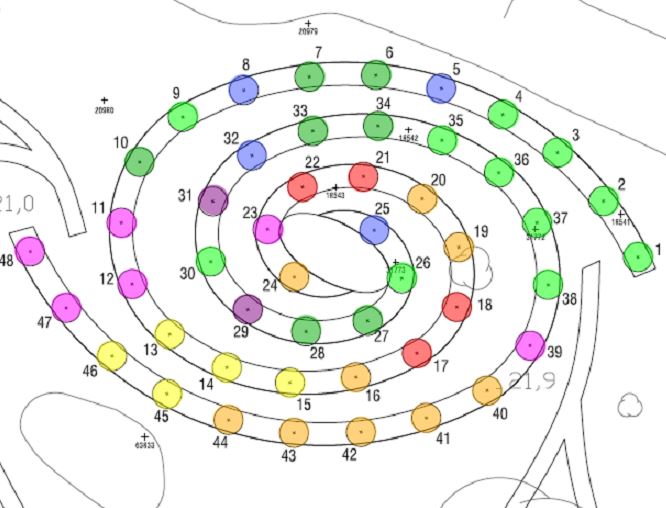
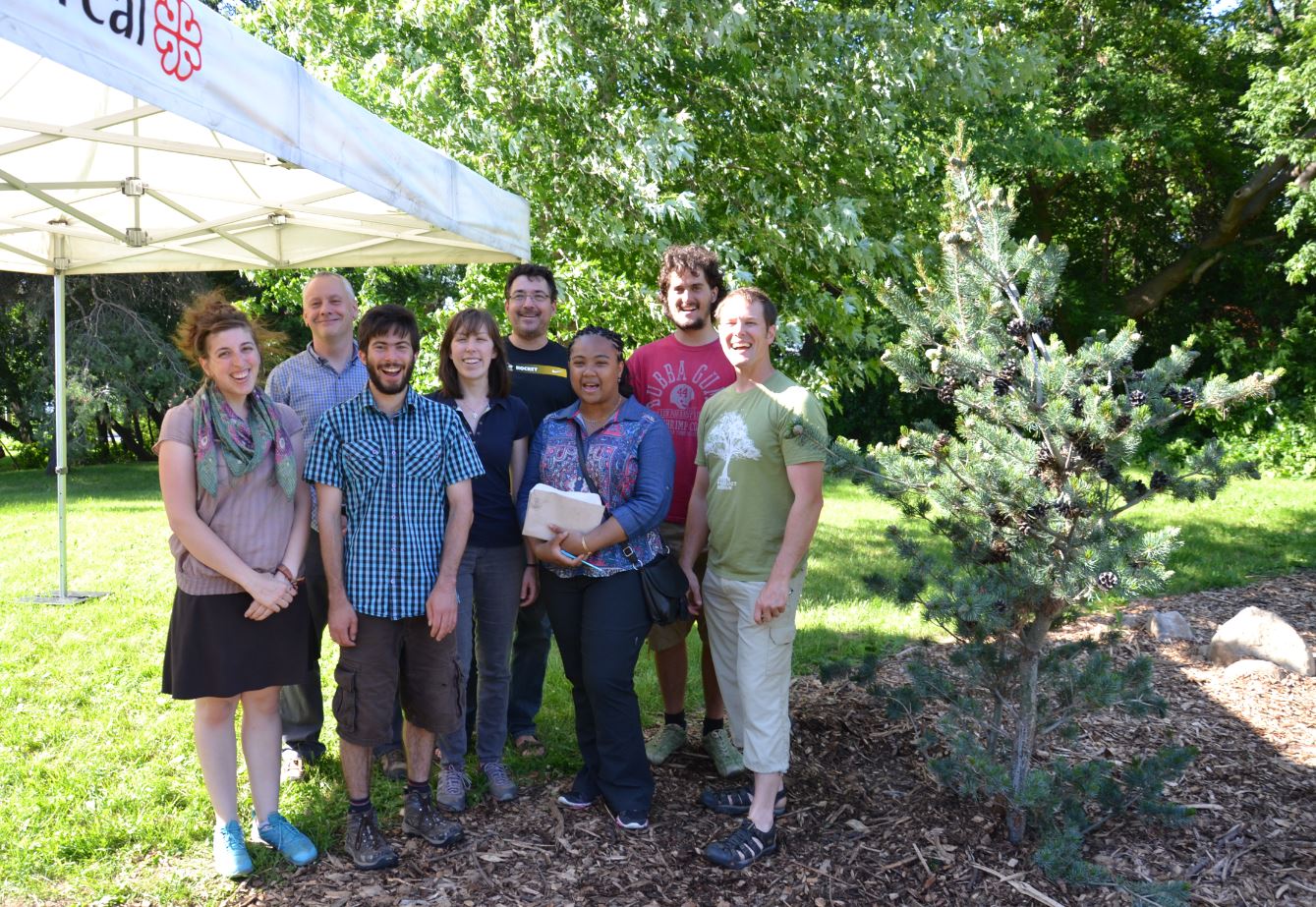
Extra information
Contact info
IDENT is a network within TreeDivNet, scientifically coordinated by Alain Paquette and Christian Messier. Each site has a local Principal Investigator, who coordinates the local research and maintenance.
| Site | Contact persons | Affiliation |
|---|---|---|
| IDENT (general) | Alain Paquette Christian Messier |
Centre for Forest Research Universitdu QuMontr P.O. Box 8888, Centre-ville Station Montreal, QC H3C 3P8 Canada |
| Auclair | Dominique Gravel | Département de biologie Université du Québec à Rimouski 300, Allée des Ursulines Rimouski, Qc, G5L 3A1 Canada |
| Cloquet | Peter Reich | Department of Forest Resources University of Minnesota St. Paul, MN 55108, USA |
| Ethiopia | Bart Muys Emiru Birhane |
Forest Nature and Landscape, KU Leuven https://ees.kuleuven.be/fnl/ Land Resources Management and Environmental Protection, Mekelle University http://www.mu.edu.et/ |
| FAB | Jeannine Cavender-Bares Rebecca Montgomery |
University of Minnesota Department of Ecology, Evolution and Behavior; Department of Forest Resources St. Paul MN 55108, USA |
| Freiburg | Michael Scherer-Lorenzen Friderike Beyer Jürgen Bauhus Peter Hajek |
University of Freiburg Chair of Geobotany Schaenzlestr. 1 79104 Freiburg, Germany |
| Outaouais | Christian Messier Benoit Gendreau-Berthiaume |
Centre for Forest Research Université du Québec à Montréal P.O. Box 8888, Centre-ville Station Montreal, QC H3C 3P8 Canada ISFORT (Institut des Sciences de la forêt tempérée), 58 rue Principale, Ripon, Qc, J0V 1V0, Canada www.isfort.uqo.ca |
| Macomer | Simone Mereu | National Research Council of Italy (CNR) Traversa la Crucca 3 07100, Sassari, Italy |
| Montreal | Alain Paquette Christian Messier |
Centre for Forest Research Université du Québec à Montréal P.O. Box 8888, Centre-ville Station Montreal, QC H3C 3P8 Canada ISFORT (Institut des Sciences de la forêt tempérée), 58 rue Principale, Ripon, Qc, J0V 1V0, Canada www.isfort.uqo.ca |
| Sault-Ste-Marie | Eric Searle William Parker |
Ontario Forest Research Institute 1235 Queen St. E. Sault Ste. Marie, ON, P6A 2E5, Canada |
PhD thesis
- Kovach, K 2021 Measurements of canopy properties to reveal biodiversity-ecosystem function relationships in tree diversity experiments using UAV remote sensing. PhD thesis, University of Freiburg
- Kothari S 2020 Blinded by the light: the functional ecology of plant-light interactions. PhD Thesis, University of Minnesota
- Grossman J 2018 Consequences of biodiversity in tree diversity experiments. PhD Thesis, University of Minnesota
- Van de Peer T 2018 Effects of tree species diversity on early-stage forest dynamics. PhD thesis, KU Leuven
- Williams L 2018 Scaling the effects of interactions among plants from individuals to ecosystems in experimental tree communities. PhD Thesis, University of Minnesota
- Khlifa R 2016 Effets de la diversité des arbres sur le fonctionnement de l’écosystème dans deux plantations de forêts tempérées. PhD thesis, Université Laval
- Garbe CM 2013 Tree functional traits. Understanding their variation - from intraspecific plasticity to the effects of trait diversity on ecosystem functioning. PhD thesis, UQAM
Research papers
- Augusto L, Borelle R, Boča A, Bon L, Orazio C, Arias-González A, Bakker MR, Gartzia-Bengoetxea H, Bernier AF, Cantero A, Cavender-Bares J, Correia AH, De Schrijver A, Diez-Casero JJ, Eisenhauer N, Fotelli MN, Gâteblé G, Godbold DL, Gomes-Caetano-Ferreira, Gundale MJ, Jactel H, Koricheva J, Larsson M, Laudicina VA, Legout A, Martín-García J, Mason WL, Meredieu C, Mereu S, Montgomery RA, Musch B, Muys B, Paillassa E, Paquette A, Parker JD, Parker WC, Ponette Q, Reynolds C, Rozados-Lorenzo MJ, Ruiz-Peinado R, Santesteban-Insausti X, Scherer-Lorenzen M, Silva-Pando FJ, Smolander A, Spyroglou G, Teixeira-Barcelos EB, Vanguelova EI, Verheyen K, Vesterdal L, Charru M 2025 Widespread slow growth of acquisitive tree species. Nature 640: 395–401 - doi: 10.1038/s41586-025-08692-x
- Damtew A, Birhane E, Messier C, Paquette A, Muys B 2025 Shading and selection effect‑mediated species mixing enhance the growth of native trees in dry tropical forests. Oecologia 207: 75 - doi/10.1007/s00442-025-05708-1
- Williams LJ, Kovach KR, Guzmán Q JA, Stefanski A, Bermudez R, Butler EE, Coq‐-Etchegaray D, Glenn‐Stone C, Hajek P, Klama J, Medlyn BE, Messier C, Moradi A, Paquette A, Park MH, Scherer-Lorenzen M, Townsend PA, Reich PB, Cavender-Bares J, Schuman MC - doi.org/10.1002/ecy.70032 2025 Tree diversity shapes the spectral signature of light transmittance in developing forests. Ecology 106: e70032 -
- Blondeel H, Guillemot J, Martin‐StPaul N, Druel A, Bilodeau‐Gauthier S, Bauhus J, … Baeten L 2024 Tree diversity reduces variability in sapling survival under drought. Journal of Ecology 112(5): 1164-1180 - https://doi.org/10.1111/1365-2745.14294
- Damtew A, Birhane E, Messier C, Paquette A, Muys B 2024 Shading and species diversity act as safety nets for seedling survival and vitality of native trees in dryland forests: Implications for restoration. Forest Ecology and Management 552: 121559 - doi/10.1016/j.foreco.2023.121559
- Jing X, Baum C, Castagneyrol B, Eisenhauer N, Ferlian O, Gebauer T, Hajek P, Jactel H, Muys B, Nock C, Ponette Q, Rose L, Saurer M, Scherer-Lorenzen M, Verheyen K, van Meerbeek K 2024 Leaf isotopes reveal tree diversity effects on the functional responses to the pan-European 2018 summer drought. New Phytologist 243:1312-1328 - doi: 10.1111/nph.19931
- Luo S, Schmid B, Hector A, Scherer‐Lorenzen M, Verheyen K, Barsoum N, Bauhus J, Beyer F, Bruelheide H, Ferlian O, Godbold D, Hall JS, Hajek P, Huang Y, Hölscher D, Kreft H, Liu X, Messier C, Nock C, Paquette A, Parker JD, Parker WC, Paterno GB, Reich PB, Rewald B, Sandén H, Sinacore K, Stefanski A, Willams L, Eisenhauer N 2024 Mycorrhizal associations modify tree diversity− productivity relationships across experimental tree plantations. New Phytologist 243:1205-1219 - doi: 10.1111/nph.19889
- Vázquez-González C, Castagneyrol B, Muiruri EW, Barbaro L, Abdala-Roberts L, Barsoum N, Fründ J, Glynn C, Jactel H, McShea WJ, Mereu S, Mooney KA, Morillas L, Nock CA, Paquette A, Parker JD, Parker, WC, Roales J, Scherer-Lorenzen M, Schuldt A, Verheyen K, Weih M, Yang B, Koricheva J 2024 Tree diversity enhances predation by birds but not by arthropods across climate gradients. Ecology Letters (27): e14427 - https://doi.org/10.1111/ele.14427
- Zheng L, Barry KE, Guerrero-Ramírez NR, Craven D, Reich PB, Verheyen K, … Hautier Y 2024 Effects of plant diversity on productivity strengthen over time due to trait-dependent shifts in species overyielding. Nature communications 15(1): 2078 - https://doi.org/10.1038/s41467-024-46355-z
- Depauw L, De Lombaerde E, Dhiedt E, Blondeel H, Abdala-Roberts L, Auge H, Barsoum N, Bauhus J, Chu C, Damtew A, Eisenhauer N, V. Fagundes M, Ganade G, Gendreau-Berthiaume B, Godbold D, Gravel D, Guillemot J, Hajek P, Hector A, Hérault B, Jactel H, Koricheva J, Kreft H, Liu X, Mereu S, Messier C, Muys B, Nock CA, Paquette A, Parker JD, Parker WC, Paterno, GB, Perring MP, Ponette Q, Potvin C, Reich PB, Rewald B, Scherer-Lorenzen M, Schnabel F, Sousa-Silva R, Weih M, Clara Zemp D, Verheyen K, Baeten L 2024 Enhancing Tree Performance Through Species Mixing: Review of a Quarter-Century of TreeDivNet Experiments Reveals Research Gaps and Practical Insights. Current Forestry Reports - https://doi.org/10.1007/s40725-023-00208-y
- Berthelot S, Bauhus J, Dormann CF, Gravel D, Messier C, Nock CA, Paquette A, Reich PB, Fründ J 2023 Exotic tree species have consistently lower herbivore load in a cross-Atlantic tree biodiversity experiment. Ecology (e4070) - https://doi.org/10.1002/ecy.4070
- Desie E, Zuo J, Verheyen K, Djukic I, Van Meerbeek K, Auge H, Barsoum N, Baum C, Bruelheide H, Eisenhauer N, Feldhaar H, Ferlian O, Gravel D, Jactel H, Kappel Schmidt I, Kepfer-Rojas S, Meredieu C, Mereu S, Messier C, Morillas L, Nock C, Paquette A, Ponette Q, Reich PB, Roales J, Scherer-Lorenzen M, Seitz S, Schmidt A, Stefanski A, Trogisch S, van Halder I, Weih M, Williams LJ, Yang B, Muys B 2023 Disentangling drivers of litter decomposition in a multi-continent network of tree diversity experiments. Science of the Total Environment 857(3): 159717 - https://doi.org/10.1016/j.scitotenv.2022.159717
- Urgoiti J, Messier C, Keeton WS, Belluau M, Paquette A 2023 Functional diversity and identity influence the self-thinning process in young forest communities. Journal of Ecology (Early View) - doi: 10.1111/1365-2745.14158
- Warner E, Cook-Patton SC, Lewis, OT, Brown N, Koricheva J, Eisenhauer N, … Hector A 2023 Young mixed planted forests store more carbon than monocultures—a meta-analysis. Frontiers in Forests and Global Change (6): 1226514
- FAO 2023 Towards more resilient and diverse planted forests. Unasylva (254)74: 2031/1. Rome. https://doi. org/10.4060/cc8584en
- Cesarz S, Craven D, Auge H, Bruelheide H, Castagneyrol B, Gutknecht J, Hector A, Jactel H, Koricheva J, Messier C, Muys B, Brien MJO, Paquette A, Ponette Q, Potvin C, Reich PB, Scherer-Lorenzen M, Smith AR, Verheyen K, Eisenhauer N 2022 Tree diversity effects on soil microbial biomass and respiration are context dependent across forest diversity experiments. Global Ecology and Biogeography 31:872-885 - https://doi.org/10.1111/geb.13461
- Hajek P, Link RM, Nock CA, Bauhus J, Gebauer T, Gessler A, Kovach K, Messier C, Paquette A, Saurer M, Scherer-Lorenzen M, Rose L, Schuldt B 2022 Mutually inclusive mechanisms of drought-induced tree mortality. Global Change Biology - https://doi.org/10.1111/gcb.16146
- Martin-Guay M-O, Belluau M, Côté B, Handa IT, Jewell MD, Khlifa R, Munson AD, Rivest M, Whalen JK, Rivest D 2022 Tree identity and diversity directly affect soil moisture and temperature but not soil carbon ten years after planting. Ecology and Evolution 12(1): e8509 - https://doi.org/10.1002/ece3.8509
- Maxwell TL, Fanin N, Parker WC, Bakker MR, Belleau A, Meredieu C, Augusto L, Munson AD 2022 Tree species identity drives nutrient use efficiency in young mixed-species plantations, at both high and low water availability. Functional Ecology - https://doi.org/10.1111/1365-2435.14109
- Melis R, Morillas L, Roales J, Costa-Saura JM, Cascio ML, Spano D, Mereu S 2022 Functional traits related to competition for light influence tree diameter increments in a biodiversity manipulation experiment. Research Square - https://doi.org/10.21203/rs.3.rs-1841505/v1
- Schuster MJ, Williams LJ, Stefanski A, Bermudez R, Belluau M, Messier C, Paquette A, Gravel D, Reich PB 2022 Patterns of belowground overyielding and fine-root biomass in native and exotic angiosperms and gymnosperms. Oikos e08877 - https://doi.org/10.1111/oik.08877
- Urgoiti J, Messier C, Keeton WS, Reich PB, Gravel D, Paquette A 2022 No complementarity no gain—Net diversity effects on tree productivity occur once complementarity emerges during early stand development. Ecology Letters 25(4): 851-862 - https://doi.org/10.1111/ele.13959
- Belluau M, Paquette A, Gravel D, Reich PB, Stefanski A, Messier C 2021 Exotics are more complementary over time in tree biodiversity–ecosystem functioning experiments. Functional Ecology 00:1– 12 - https://doi.org/10.1111/1365-2435.13900
- Belluau M, Vitali V, Parker WC, Paquette A, Messier C 2021 Overyielding in young tree communities does not support the stress-gradient hypothesis and is favoured by functional diversity and higher water availability. Journal of Ecology - DOI: 10.1111/1365-2745.13602
- Berthelot S, Frühbrodt T, Hajek P, Nock CA, Dormann CF, Bauhus J, Fründ J 2021 Tree diversity reduces the risk of bark beetle infestation for preferred conifer species, but increases the risk for less preferred hosts. Journal of Ecology 109(7) 2649-2661 - https://doi.org/10.1111/1365-2745.1367
- Kothari S, Montgomery RA, Cavender-Bares J 2021 Physiological responses to light explain competition and facilitation in a tree diversity experiment. Journal of Ecology 109:2000-2018 - https://doi.org/10.1111/1365-2745.13637
- Kwon T, Shibata H, Kepfer-Rojas S, Schmidt IK, Larsen KS, Beier C, Berg B, Verheyen K, Lamarque J-F, Hagedorn F, Eisenhauer N, Djukic I, TeaCompositionNetwork 2021 Effects of climate and atmospheric nitrogen deposition on early to mid-term stage litter decomposition across biomes. Frontiers in Forests and Global Change 4: 678480 - https://doi.org/10.3389/ffgc.2021.678480
- Strukelj M, Parker W, Corcket E, Augusto L, Khlifa R, Jactel H, Munson AD 2021 Tree species richness and water availability interact to affect soil microbial processes. Soil Biology and Biochemistry, 108180. https://doi.org/10.1016/j.soilbio.2021.108180
- Williams LJ, Butler EE, Cavender-Bares J, Stefanski A, Rice KE, Messier C, Paquette A, Reich PB 2021 Enhanced light interception and light use efficiency explain overyielding in young tree communities. Ecology Letters 24(5): 996-1006 - https://doi.org/10.1111/ele.13717
- Messier C, Bauhus J, Sousa-Silva R, Auge H, Baeten L, Barsoum N, Bruelheide H, Caldwell B, Cavender-Bares J, Dhiedt E, Eisenhauer N, Ganade G, Gravel D, Guillemot J, Hall JS, Hector A, Hérault B, Jactel H, Koricheva J, Kreft H, Mereu S, Muys B, Nock CA, Paquette A, Parker JD, Perring MP, Ponette Q, Potvin C, Reich PB, Scherer-Lorenzen M, Schnabel F, Verheyen K, Weih M, Wollni M, Zemp DC 2021 For the sake of resilience and multifunctionality, let’s diversify planted forests! Conservation Letters e12829 - https://doi.org/10.1111/conl.12829
- Grossman JJ, Cavender-Bares J, Hobbie SE 2020 Functional diversity of leaf litter mixtures slows decomposition of labile but not recalcitrant carbon over two years. Ecological Monographs 90:e01407 - https://doi.org/10.1002/ecm.1407
- Poeydebat C, Jactel H, Moreira X, Koricheva J, Barsoum N, Bauhus J, Eisenhauer N, Ferlian O, Francisco M, Gottschall F, Gravel D, Mason B, Muiruri E, Muys B, Nock C, Paquette A, Ponette Q, Scherer‐Lorenzen M, Stokes V, Staab M, Verheyen K and Castagneyrol B 2020 Climate affects neighbour‐induced changes in leaf chemical defences and tree diversity‐herbivory relationships. Functional Ecology - doi:10.1111/1365-2435.13700
- Williams LJ, Cavender-Bares J, Paquette A, Messier C, Reich PB 2020 Light mediates the relationship between community diversity and trait plasticity in functionally and phylogenetically diverse tree mixtures. Journal of Ecology 108(4): 1617-1634 - https://doi.org/10.1111/1365-2745.13346
- Williams LJ, Cavender-Bares J, Townsend PA, Couture JJ, Wang Z, Stefanski A, Messier C, Reich PB 2020 Remote spectral detection of biodiversity effects on forest biomass. Nature Ecology & Evolution - doi:10.1038/s41559-020-01329-4
- Archambault C, Paquette A, Messier C, Khlifa R, Munson AD, Handa I T 2019 Evergreenness influences fine root growth more than tree diversity in a common garden experiment. Oecologia 189: 1027-1039 - https://doi.org/10.1007/s00442-019-04373-5
- Garau G, Morillas L, Roales J, Castaldi P, Mangia NP, Spano D, Mereu S 2019 Effect of monospecific and mixed Mediterranean tree plantations on soil microbial community and biochemical functioning. Applied Soil Ecology 140: 78-88 - https://doi.org/10.1016/j.apsoil.2019.04.005
- Grossman JJ, Butterfield AJ, Cavender-Bares J, Hobbie SE, Reich PB, Gutknecht J, Kennedy PG 2019 Non-symbiotic soil microbes are more strongly influenced by altered tree biodiversity than arbuscular mycorrhizal fungi during initial forest establishment. FEMS Microbiology Ecology 95(10) - https://doi.org/10.1093/femsec/fiz134
- Grossman JJ, Cavender-Bares J, Reich PB, Montgomery RA, Hobbie SE 2019 Neighborhood diversity simultaneously increased and decreased susceptibility to contrasting herbivores in an early stage forest diversity experiment. Journal of Ecology 107:1492-1505 - https://doi.org/10.1111/1365-2745.13097
- Martin-Guay MO, Paquette A, Reich PB, Messier C 2019 Implications of contrasted above- and below-ground biomass responses in a diversity experiment with trees. Journal of Ecology 108(2): 405-414 - doi: 10.1111/1365-2745.13265
- Raymond-Léonard L J, Gravel D, Handa I T 2019 A novel set of traits to describe Collembola mouthparts: taking a bite out of the broad chewing mandible classification. Soil Biology and Biochemistry 138: 107608 - https://doi.org/10.1016/j.soilbio.2019.107608
- Rissanen K, Martin-Guay M-O, Riopel-Bouvier A-S, Paquette A 2019 Light interception in experimental forests affected by tree diversity and structural complexity of dominant canopy. Agricultural and Forest Meteorology 278: 107655 - https://doi.org/10.1016/j.agrformet.2019.107655
- Rivest M, Whalen JK, Rivest D 2019 Tree diversity is not always a strong driver of soil microbial diversity: a 7-yr-old diversity experiment with trees. Ecosphere 10(4): e02685 - https://doi.org/10.1002/ecs2.2685
- Djukic I, Kepfer-Rojas S, Kappel Schmidt I, Steenberg Larsen K, Beier C, Berg B, Verheyen K, TeaComposition 2018 Early stage litter decomposition across biomes. Science of the Total Environment 628-629: 1369-1394 - doi: 10.1016/j.scitotenv.2018.01.012
- Raymond-Léonard L J, Gravel D, Reich P B, Handa I T 2018 Springtail community structure is influenced by functional traits but not biogeographic origin of leaf litter in soils of novel forest ecosystems. Proceedings of the Royal Society B: Biological Sciences, 285(1879) - https://doi.org/10.1098/rspb.2018.0647
- Ruiz-González C, Archambault E, Laforest-Lapointe I, del Giorgio P A, Kembel S W, Messier C, Beisner B E 2018 Soils associated to different tree communities do not elicit predictable responses in lake bacterial community structure and function. FEMS Microbiology Ecology 94(8) - https://doi.org/10.1093/femsec/fiy115
- Van de Peer T, Mereu S, Verheyen K, Costa Saura JM, Morillas L, Roales J, Lo Cascio M, Spano D, Paquette A, Muys B 2018 Tree seedling vitality improves with functional diversity in a Mediterranean common garden experiment. Forest Ecology and Management 409: 614-633, doi: 10.1016/j.foreco.2017.12.001
- Grossman JJ, Vanhellemont M, Barsoum N, Bauhus J, Bruelheide H, Castagneyrol B, Cavender-Bares J, Eisenhauer N, Ferlian O, Gravel D, Hector A, Jactel H, Kreft H, Mereu S, Messier C, Muys B, Nock C, Paquette A, Parker J, Perring MP, Ponette Q, Reich PB, Schuldt A, Staab M, Weih M, Zemp DC, Scherer-Lorenzen M, Verheyen K 2018 Synthesis and future research directions linking tree diversity to growth, survival, and damage in a global network of tree diversity experiments. Environmental and Experimental Botany 152: 68-89 - doi: 10.1016/j.envexpbot.2017.12.015
- Grossman JJ, Cavender-Bares J, Hobbie SE, Reich PB, Montgomery R 2017 Species richness and traits predict overyielding in stem growth in an early-successional tree diversity experiment. Ecology 98: 2601-2614 - doi: 10.1002/ecy.1958
- Jewell MD, Shipley B, Low-Décarie E, Tobner CM, Paquette A, Messier C, Reich PB 2017 Partitioning the effect of composition and diversity of tree communities on leaf litter decomposition and soil respiration. Oikos 126:959-971 - doi: 10.1111/oik.03868
- Khlifa R, Paquette A, Messier C, Reich PB, Munson AD 2017 Do temperate tree species diversity and identity influence soil microbial community function and composition? Ecology and Evolution 7: 7965-7974 - doi: 10.1002/ece3.3313
- Laforest-Lapointe I, Paquette A, Messier C, Kembel SW 2017 Leaf bacterial diversity mediates plant diversity and ecosystem function relationships. Nature 546: 145-147 - doi: 10.1038/nature22399
- Williams LJ, Paquette A, Cavender-Bares J, Messier C, Reich PB 2017 Spatial complementarity in tree crowns explains overyielding in species mixtures. Nature Ecology & Evolution 1: 0063 - doi: 10.1038/s41559-016-0063
- Nguyen NH, Williams L, Vincent JB, Stefanski A, Cavender-Bares J, Messier C, Paquette A, Gravel D, Reich PB, Kennedy PG 2016 Ectomycorrhizal and saprotrophic fungal diversity are linked to different tree community attributes in a field-based tree experiment. Molecular Ecology 25: 4032-4046 - doi: 10.1111/mec.13719
- Pourhassan N, Bruno S, Jewell MD, Shipley B, Roy S, Bellenger J-P 2016 Phosphorus and micronutrient dynamics during gymnosperm and angiosperm litters decomposition in temperate cold forest from Eastern Canada. Geoderma 273: 25-31 - doi: 10.1016/j.geoderma.2016.03.018
- Tobner CM, Paquette A, Gravel D, Reich PB, Williams LJ, Messier C 2016 Functional identity is the main driver of diversity effects in young tree communities. Ecology Letters 19: 638-647 - doi: 10.1111/ele.12600
- Wein A, Bauhus J, Bilodeau-Gauthier, Scherer-Lorenzen M, Nock C, Staab M 2016 Tree species richness promotes invertebrate herbivory on congeneric native and exotic tree saplings in a young diversity experiment. PLoS ONE 11: e0168751 - doi: 10.1371/journal.pone.0168751
- Jewell MD, Shipley B, Paquette A, Messier C, Reich PB 2015 A traits-based test of the home-field advantage in mixed-species tree litter decomposition. Annals of Botany 116: 781-788 - doi: 10.1093/aob/mcv105
- Rivest D, Paquette A, Shipley B, Reich PB, Messier C 2015 Tree communities rapidly alter soil microbial resistance and resilience to drought. Functional Ecology 29: 570-578 - doi: 10.1111/1365-2435.12364
- Paine CET, Amissah L, Auge H, Baraloto C, Baruffol M, Bourland N, Bruelheide H, Daïnou K, de Gouvenain RC, Doucet J-L, Doust S, Fine PVA, Fortunel C, Haase J, Holl KD, Jactel H, Li X, Kitajima K, Koricheva J, Martínez-Garza C, Messier C, Paquette A, Philipson C, Piotto D, Poorter L, Posada JM, Potvin C, Rainio K, Russo SE, Ruiz-Jaen M, Scherer-Lorenzen M, Webb CO, Wright SJ, Zahawi RA, Hector A 2015 Globally, functional traits are weak predictors of juvenile tree growth, and we do not know why. Journal of Ecology 103: 978-989 - doi: 10.1111/1365-2745.12401
- Tobner CM, Paquette A, Reich PB, Gravel D, Messier C 2014 Advancing biodiversity-ecosystem functioning science using high-density tree-based experiments over functional diversity gradients. Oecologia 174: 609-621 - doi: 10.1007/s00442-013-2815-4
- Tobner CM, Paquette A, Messier C 2013 Interspecific coordination and intraspecific plasticity of fine root traits in North American temperate tree species. Frontiers in Plant Science 4(242): 1-11 - doi: 10.3389/fpls.2013.00242
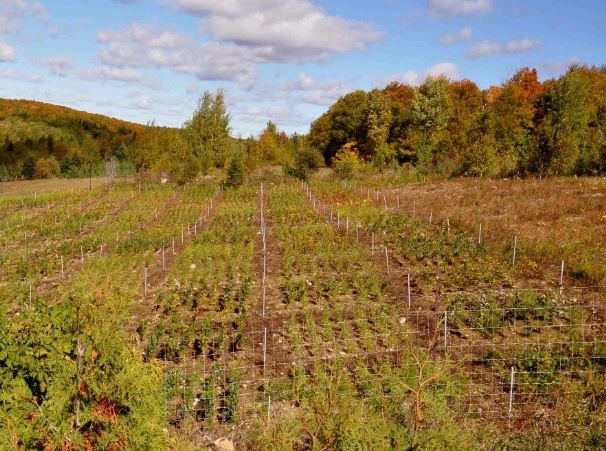
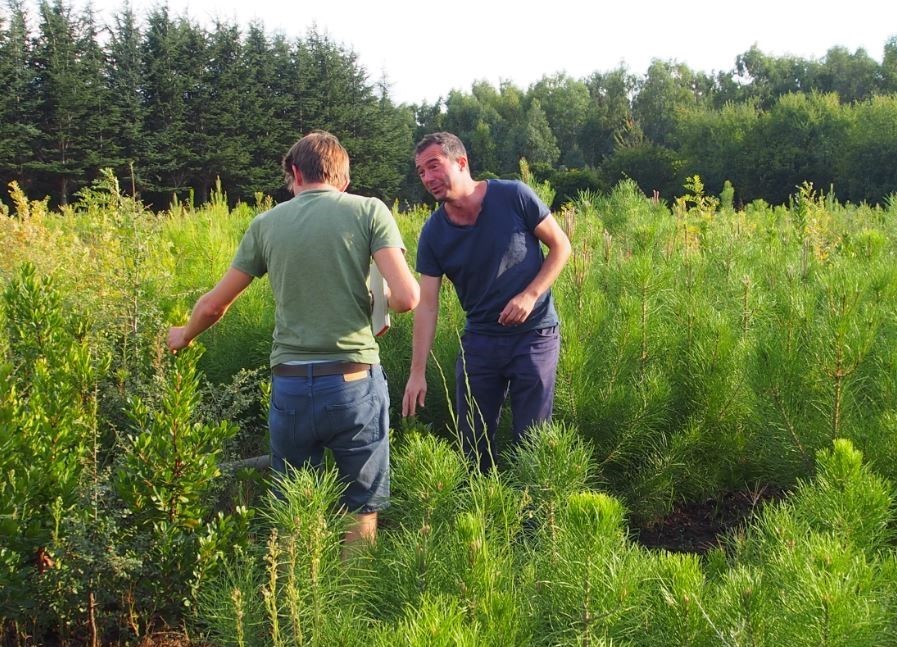
The Auclair and Macomer sites one and two years after planting (fall 2010, summer 2015)
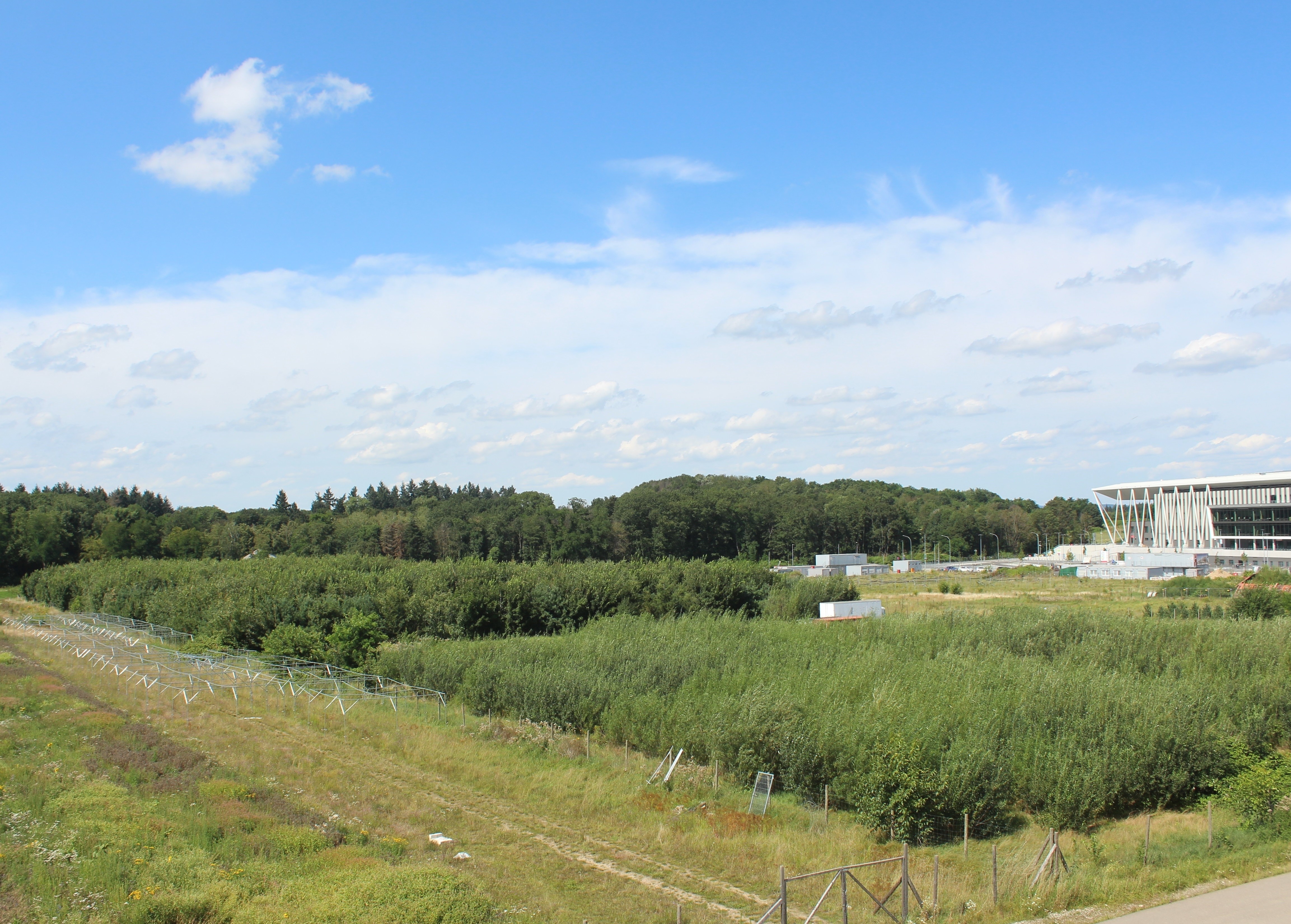
(left) The Montreal site six years after planting (summer 2015 (EXO-Tactik)). (right) The IDENT Freiburg site and ECOLINK-Salix site (Summer 2021, Peter Hajek).
